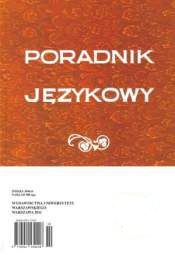FLEKSJA I SKŁADNIA LICZEBNIKÓW W ROZMYŚLANIU PRZEMYSKIM - ŁĄCZLIWOŚĆ Z RZECZOWNIKIEM
Inflection and Syntax of Numerals in Rozmyślanie przemyskie Connectability with Nouns, Part 2.
Author(s): Alina KępińskaSubject(s): Language and Literature Studies
Published by: Dom Wydawniczy ELIPSA
Keywords: Rozmyślania przemyskie; składnia; liczebniki; staropolszczyzna
Summary/Abstract: The second part of the article analyses inflection of general numerals from 5 to 10, mass and various numerals featuring in Rozmyślanie przemyskie, the vastest 16-century apocryph in connection with the form of the described noun. Numerals from 5 to 10 still have the old declinational endings, e.g. piąci, sześci, siedmi, dziesiąci, piącią, siedmią. Syntactic differences in comparison with contemporary forms result from the lack of masculine-personal category on the one hand, e.g. dziesięć mężów, and from the beginnings of the syntactic agreement (which is obligatory nowadays), occurring beside the former syntactic reign on the other, e.g. siedmi pannam, dziesiąci dziewicam, o dziesiąci dziewicach, po siedmi lat, po dziesiąci lat, nad piącią miast. Among inflectional forms of mass numerals, of which only the former neutral gender singular has survived, there are remnants of both other genders e.g. siedmiora prośba, dwoj lud, dwoję rzecz and other numbers, e.g. dwoja elementa, pięciory księgi. These examples prove the original congruence between this kind of numerals and nouns, e.g. dziesięcioro przykazanie, o dziewięcioru błogosławieniu. There are, however, some examples of the syntactic reign, e.g. dwoje garliczek. The linguistic relict shows formation process of morphological dominants on the one hand and non-stable syntax between numerals and nouns on the other hand.
Journal: Poradnik Językowy
- Issue Year: 2005
- Issue No: 05
- Page Range: 33-50
- Page Count: 18
- Language: Polish
- Content File-PDF

